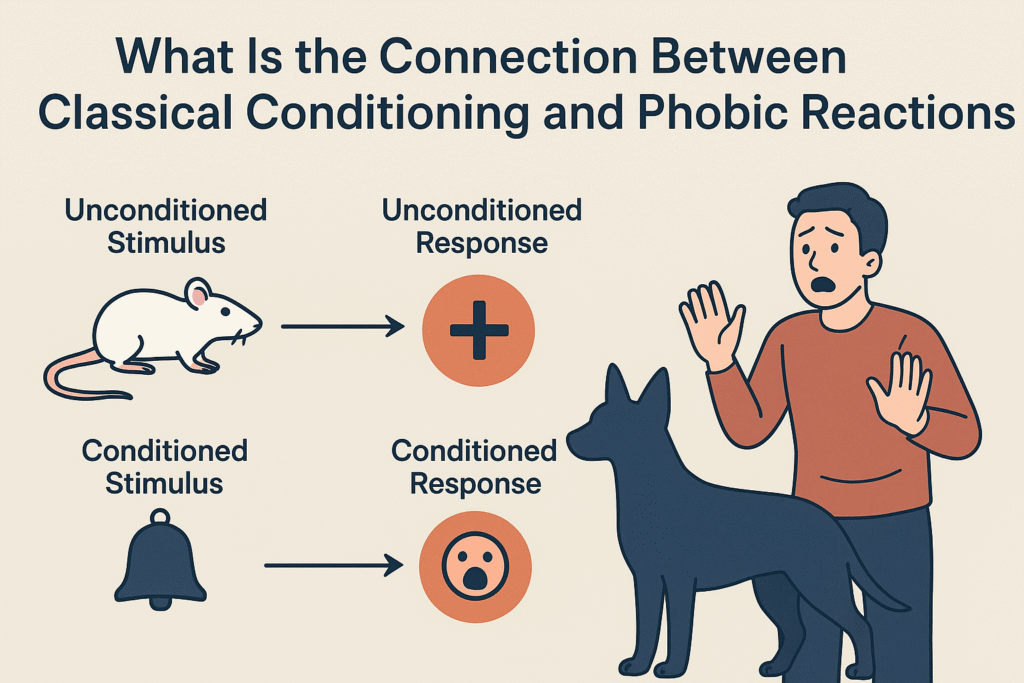Understanding why people develop intense fears, or phobias, has long fascinated psychologists. One of the most influential explanations comes from behavioral psychology classical conditioning. This powerful learning process helps explain how a once-neutral stimulus can become linked to fear and avoidance.
In this article, we’ll explore the connection between classical conditioning and phobic reactions, including how phobias are formed, maintained, and treated using behavioral methods. By the end, you’ll understand how seemingly simple learning principles can shape deeply ingrained emotional responses.
Understanding Classical Conditioning: The Basics
Before diving into phobias, it’s essential to understand what classical conditioning is. The concept was first introduced by Ivan Pavlov, a Russian physiologist, through his famous experiments with dogs.
Pavlov noticed that dogs began to salivate not only when food was presented but also when they heard the footsteps of the person bringing the food. Through repeated pairings, the dogs learned to associate a previously neutral stimulus (the footsteps or a bell) with food, eventually responding to it automatically.
This form of learning became known as classical conditioning, where an organism learns to associate two stimuli one that naturally elicits a response and another that does not until both produce the same reaction.
Key Elements of Classical Conditioning
To understand how classical conditioning and phobias are connected, let’s break down its core components:
- Unconditioned Stimulus (UCS): A stimulus that naturally triggers a response (e.g., a loud noise).
- Unconditioned Response (UCR): The natural, automatic reaction to the UCS (e.g., fear or startle).
- Conditioned Stimulus (CS): A previously neutral stimulus that becomes associated with the UCS (e.g., a white rat).
- Conditioned Response (CR): The learned response to the CS, often similar to the UCR (e.g., fear when seeing the rat).
Through this process, a neutral event can evoke a strong emotional reaction, such as fear the foundation of phobic learning.
How Classical Conditioning Leads to Phobias
Now that we understand the mechanics, let’s explore how phobic reactions develop through classical conditioning.
Phobias often begin with a negative or traumatic experience that pairs fear with a specific object, situation, or event. Over time, that object or event alone becomes capable of triggering an intense fear response even when no real danger exists.
The Famous Case of “Little Albert”
One of the most cited examples illustrating the link between classical conditioning and phobias is the case of “Little Albert”, a study conducted by John B. Watson and Rosalie Rayner in 1920.
In the experiment, an infant named Albert was shown a white rat (a neutral stimulus). Initially, he had no fear. However, researchers paired the rat’s appearance with a loud, frightening noise (the unconditioned stimulus). After several pairings, Albert began to cry and show fear when he saw the rat even without the noise.
Later, this fear generalized to other white, furry objects, such as a rabbit or Santa Claus beard. This case demonstrated how a neutral stimulus can become associated with fear through classical conditioning, creating a lasting phobia.
The Psychological Process Behind Phobic Learning
The connection between classical conditioning and phobic reactions can be broken down into a few psychological processes:
1. Acquisition
This is the initial stage where the phobia forms. A traumatic or frightening event links the conditioned stimulus (e.g., dogs) with a fear-inducing event (e.g., being bitten). The brain encodes this association quickly and deeply, especially when emotions like fear are involved.
2. Generalization
Once a phobic response is learned, it can spread to similar stimuli. For instance, if someone is bitten by a small dog, they might develop fear toward all dogs, not just the one that bit them.
3. Maintenance and Avoidance
Avoidance is what maintains a phobia. By staying away from the feared object or situation, the person never has the chance to “unlearn” the fear. Avoidance provides short-term relief, but it reinforces the idea that the stimulus is dangerous.
4. Extinction
Phobias can diminish when the conditioned stimulus is repeatedly presented without the unconditioned stimulus. For example, if someone with a dog phobia spends time around friendly, calm dogs, their fear can gradually weaken.
Real-Life Examples of Classical Conditioning and Phobias
Classical conditioning explains many common phobic reactions people experience in daily life:
- Fear of flying: A person might develop aviophobia after a single turbulent flight or emergency landing.
- Fear of water: Someone who nearly drowned as a child might develop aquaphobia.
- Fear of needles: A painful vaccination experience could trigger needle phobia.
- Fear of animals: Being chased or bitten by a dog or insect can cause lifelong fear.
Each of these examples shows how a neutral stimulus (e.g., an airplane, water, or dog) becomes associated with a fearful experience, leading to persistent avoidance.
Biological and Cognitive Factors in Phobia Formation
While classical conditioning provides a strong behavioral explanation, it doesn’t act alone. Biological and cognitive influences also play a part in shaping phobic reactions.
1. Biological Preparedness
Humans are evolutionarily predisposed to fear certain things like snakes, spiders, and heights because such fears once protected our ancestors from harm. This makes it easier to condition phobias toward these stimuli than toward neutral ones, like flowers or chairs.
2. Cognitive Interpretation
How we think about a traumatic event affects whether a phobia forms. For instance, someone might rationalize a frightening dog encounter as a one-time incident, while another person might internalize it as proof that “all dogs are dangerous.”
Thus, both learning and perception contribute to the development of phobias.
Breaking the Cycle: How Therapy Uses Classical Conditioning Principles
Interestingly, the same learning principles that cause phobias can also help treat them. Behavioral therapists often use classical conditioning techniques to help individuals overcome fear.
1. Exposure Therapy
This is one of the most effective treatments for phobias. It involves gradually exposing the individual to the feared stimulus in a safe, controlled setting. Over time, repeated exposure without negative consequences weakens the conditioned fear response, a process known as extinction.
2. Systematic Desensitization
This approach combines relaxation techniques with gradual exposure. The person learns to stay calm while confronting progressively more anxiety-inducing versions of the feared stimulus. It’s a step-by-step process that retrains the brain’s fear response.
3. Counter-Conditioning
Here, therapists pair the feared stimulus with a positive or calming experience instead of a negative one. For example, someone afraid of dogs might be encouraged to play with a gentle puppy while listening to soothing music, replacing fear with comfort.
Modern Perspectives on Classical Conditioning and Phobias
While classical conditioning remains a cornerstone of behavioral psychology, modern research highlights the complex interplay between biological predispositions, cognitive processes, and emotional memory.
Today, therapists often use cognitive-behavioral therapy (CBT) alongside conditioning-based methods to address both the learned fear and the thought patterns that sustain it.
Technological tools, such as virtual reality exposure therapy, also utilize the principles of classical conditioning by safely recreating fearful environments for controlled desensitization.
The Role of Professional Help
If a phobia interferes with daily life such as avoiding work, travel, or social situations professional intervention becomes necessary. Licensed psychologists and psychiatrists can assess the root causes of phobias and design personalized treatment plans based on behavioral principles.
Platforms like ExpertMinds connect individuals with qualified mental health professionals who understand how classical conditioning and phobias interact. With proper support, even long-standing fears can be managed and reduced.
Final Thoughts
The link between classical conditioning and phobic reactions is one of the most compelling examples of how experience shapes emotion and behavior. What begins as a single frightening event can, through learned association, evolve into a powerful and persistent fear.
However, just as phobias are learned, they can also be unlearned. With behavioral therapies, cognitive restructuring, and the right professional guidance, individuals can break free from the cycle of fear and reclaim control over their lives.



